display Citroen BERLINGO MULTISPACE RHD 2013.5 2.G Owner's Manual
[x] Cancel search | Manufacturer: CITROEN, Model Year: 2013.5, Model line: BERLINGO MULTISPACE RHD, Model: Citroen BERLINGO MULTISPACE RHD 2013.5 2.GPages: 268, PDF Size: 13.36 MB
Page 17 of 268
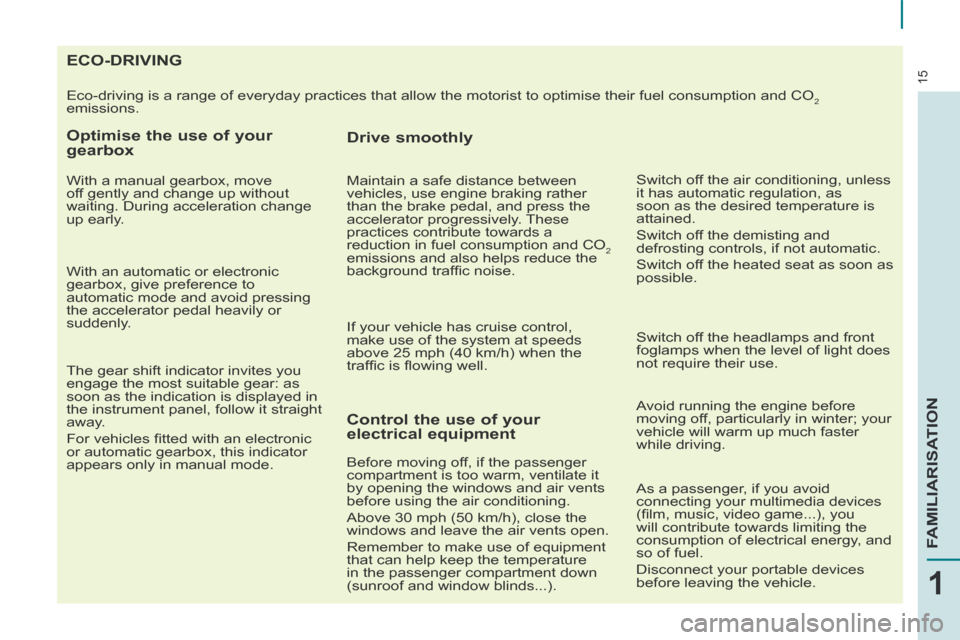
15
1
FAMILIARISATION
ECO-DRIVING
Eco-driving is a range of everyday practices that allow the motorist to \
optimise their fuel consumption and CO2
emissions.
Optimise the use of your
gearbox
With a manual gearbox, move
off gently and change up without
waiting. During acceleration change
up early.
With an automatic or electronic
gearbox, give preference to
automatic mode and avoid pressing
the accelerator pedal heavily or
suddenly.
Control the use of your
electrical equipment
Before moving off, if the passenger
compartment is too warm, ventilate it
by opening the windows and air vents
before using the air conditioning.
Above 30 mph (50 km/h), close the
windows and leave the air vents open.
Remember to make use of equipment
that can help keep the temperature
in the passenger compartment down
(sunroof and window blinds...). Switch off the headlamps and front
foglamps when the level of light does
not require their use.
Avoid running the engine before
moving off, particularly in winter; your
vehicle will warm up much faster
while driving.
Drive smoothly
Maintain a safe distance between
vehicles, use engine braking rather
than the brake pedal, and press the
accelerator progressively. These
practices contribute towards a
reduction in fuel consumption and CO
2
emissions and also helps reduce the
background traffi c noise.
If your vehicle has cruise control,
make use of the system at speeds
above 25 mph (40 km/h) when the
traffi c is fl owing well.
As a passenger, if you avoid
connecting your multimedia devices
(fi lm, music, video game...), you
will contribute towards limiting the
consumption of electrical energy, and
so of fuel.
Disconnect your portable devices
before leaving the vehicle. Switch off the air conditioning, unless
it has automatic regulation, as
soon as the desired temperature is
attained.
Switch off the demisting and
defrosting controls, if not automatic.
Switch off the heated seat as soon as
possible.
The gear shift indicator invites you
engage the most suitable gear: as
soon as the indication is displayed in
the instrument panel, follow it straight
away.
For vehicles fi tted with an electronic
or automatic gearbox, this indicator
appears only in manual mode.
Page 29 of 268
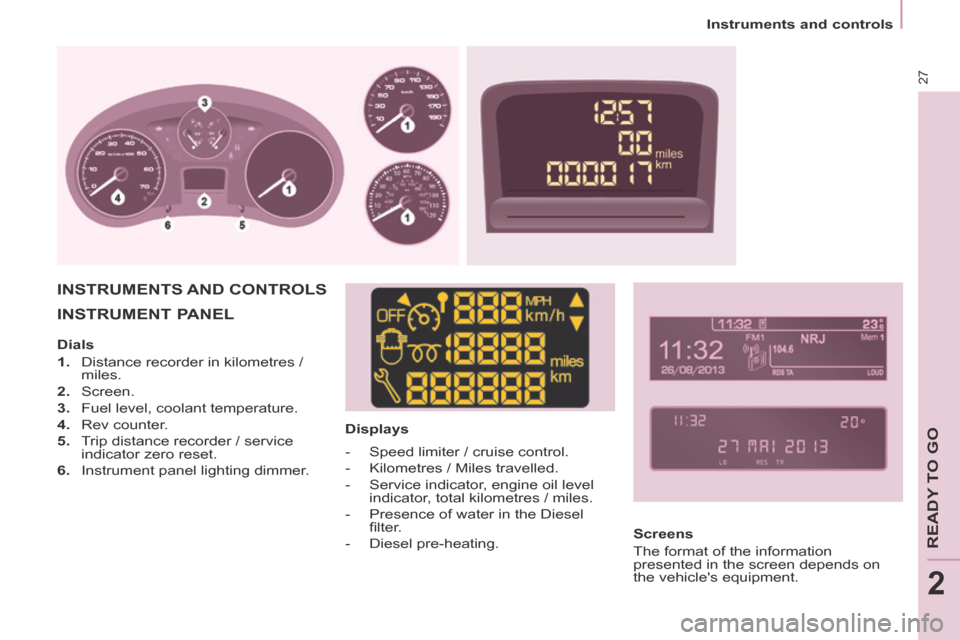
2
Instruments and controls
27
READY TO GO
INSTRUMENT PANEL
Displays
INSTRUMENTS AND CONTROLS
Screens
The format of the information
presented in the screen depends on
the vehicle's equipment.
Dials
1. Distance recorder in kilometres /
miles.
2. Screen.
3. Fuel level, coolant temperature.
4. Rev counter.
5. Trip distance recorder / service indicator zero reset.
6. Instrument panel lighting dimmer. - Speed limiter / cruise control.
- Kilometres / Miles travelled.
- Service indicator, engine oil level
indicator, total kilometres / miles.
- Presence of water in the Diesel fi lter.
- Diesel pre-heating.
Page 30 of 268
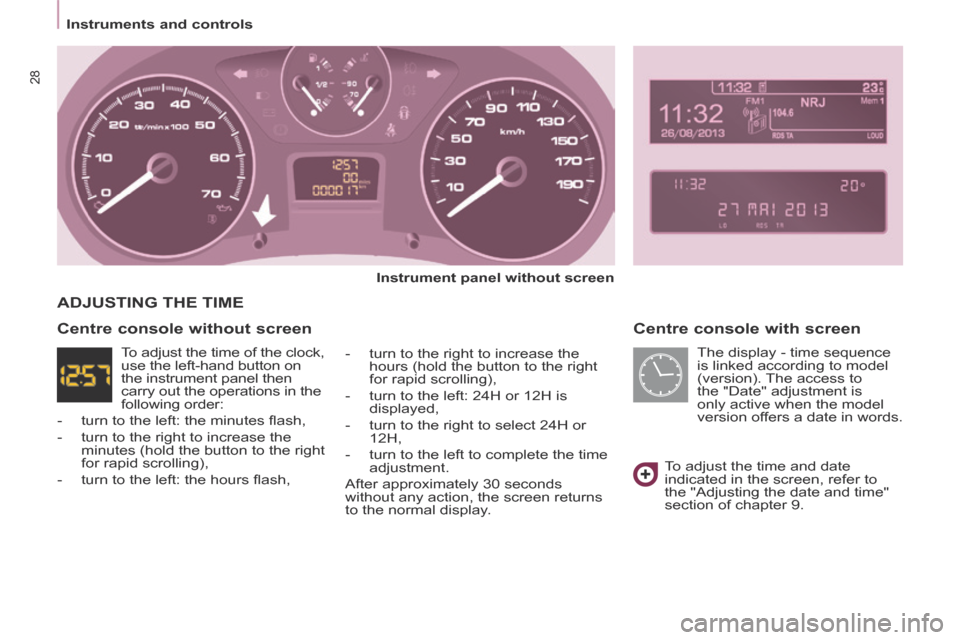
Instruments and controls
28
Centre console with screen
Instrument panel without screen
- turn to the right to increase the hours (hold the button to the right
for rapid scrolling),
- turn to the left: 24H or 12H is displayed,
- turn to the right to select 24H or 12H,
- turn to the left to complete the time adjustment.
After approximately 30 seconds
without any action, the screen returns
to the normal display.
ADJUSTING THE TIME
To adjust the time and date
indicated in the screen, refer to
the "Adjusting the date and time"
section of chapter 9.
Centre console without screen
The display - time sequence
is linked according to model
(version). The access to
the "Date" adjustment is
only active when the model
version offers a date in words.
To adjust the time of the clock,
use the left-hand button on
the instrument panel then
carry out the operations in the
following order:
- turn to the left: the minutes fl ash,
- turn to the right to increase the minutes (hold the button to the right
for rapid scrolling),
- turn to the left: the hours fl ash,
Page 32 of 268
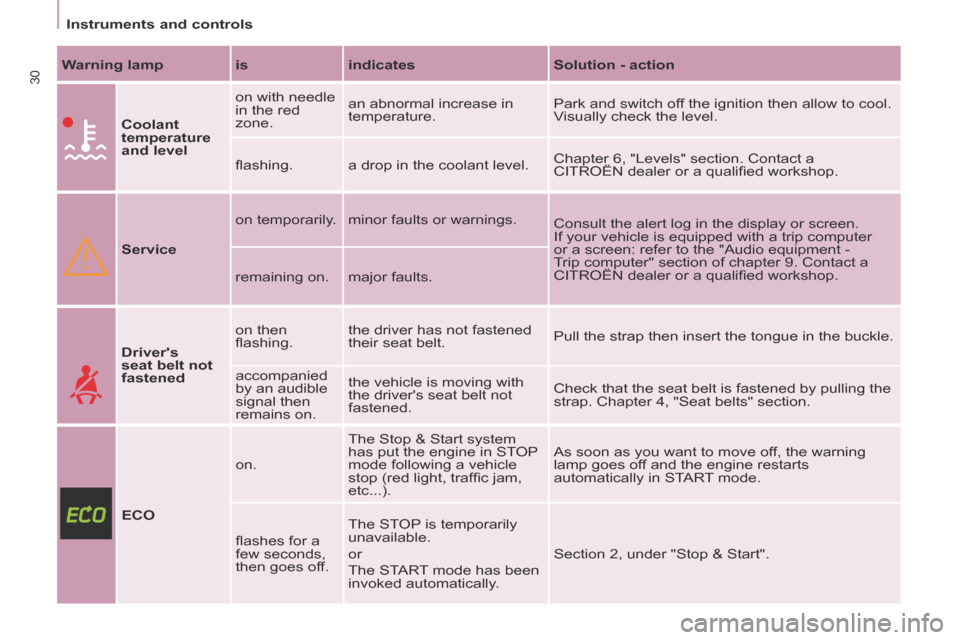
Instruments and controls
30 Warning lamp is indicates Solution - action
Coolant
temperature
and level on with needle
in the red
zone.
an abnormal increase in
temperature.
Park and switch off the ignition then allow to cool.
Visually check the level.
fl ashing. a drop in the coolant level. Chapter 6, "Levels" section. Contact a
CITROËN dealer or a qualifi ed workshop.
Service on temporarily.
minor faults or warnings.
Consult the alert log in the display or screen.
If your vehicle is equipped with a trip computer
or a screen: refer to the "Audio equipment -
Trip computer" section of chapter 9. Contact a
CITROËN dealer or a qualifi ed workshop.
remaining on. major faults.
Driver's
seat belt not
fastened on then
fl ashing.
the driver has not fastened
their seat belt.
Pull the strap then insert the tongue in the buckle.
accompanied
by an audible
signal then
remains on. the vehicle is moving with
the driver's seat belt not
fastened.
Check that the seat belt is fastened by pulling the
strap. Chapter 4, "Seat belts" section.
ECO on.
The Stop & Start system
has put the engine in STOP
mode following a vehicle
stop (red light, traffi c jam,
etc...). As soon as you want to move off, the warning
lamp goes off and the engine restarts
automatically in START mode.
fl ashes for a
few seconds,
then goes off. The STOP is temporarily
unavailable.
or
The START mode has been
invoked automatically.
Section 2, under "Stop & Start".
Page 34 of 268
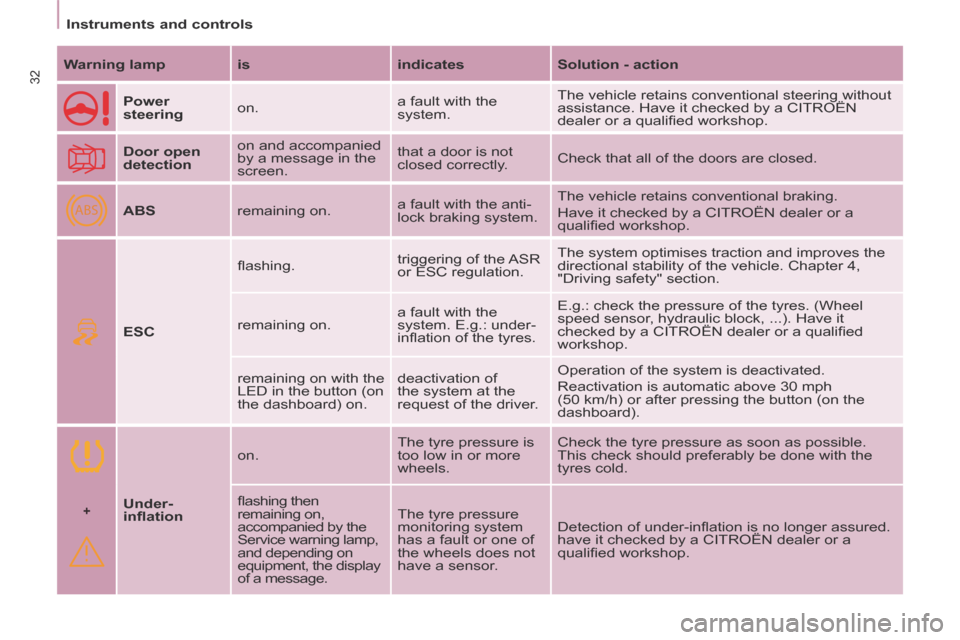
+
ABS
Instruments and controls
32 Warning lamp is indicates Solution - action
Power
steering on. a fault with the
system. The vehicle retains conventional steering without
assistance. Have it checked by a CITROËN
dealer or a qualifi ed workshop.
Door open
detection on and accompanied
by a message in the
screen. that a door is not
closed correctly.
Check that all of the doors are closed.
ABS remaining on. a fault with the anti-
lock braking system. The vehicle retains conventional braking.
Have it checked by a CITROËN dealer or a
qualifi ed workshop.
ESC fl ashing.
triggering of the ASR
or ESC regulation. The system optimises traction and improves the
directional stability of the vehicle. Chapter 4,
"Driving safety" section.
remaining on. a fault with the
system. E.g.: under-
infl ation of the tyres. E.g.: check the pressure of the tyres. (Wheel
speed sensor, hydraulic block, ...). Have it
checked by a CITROËN dealer or a qualifi ed
workshop.
remaining on with the
LED in the button (on
the dashboard) on. deactivation of
the system at the
request of the driver. Operation of the system is deactivated.
Reactivation is automatic above 30 mph
(50 km/h) or after pressing the button (on the
dashboard).
Under-
infl ation on.
The tyre pressure is
too low in or more
wheels. Check the tyre pressure as soon as possible.
This check should preferably be done with the
tyres cold.
fl ashing then
remaining on,
accompanied by the
Service warning lamp,
and depending on
equipment, the display
of a message. The tyre pressure
monitoring system
has a fault or one of
the wheels does not
have a sensor.
Detection of under-infl ation is no longer assured.
have it checked by a CITROËN dealer or a
qualifi ed workshop.
Page 39 of 268
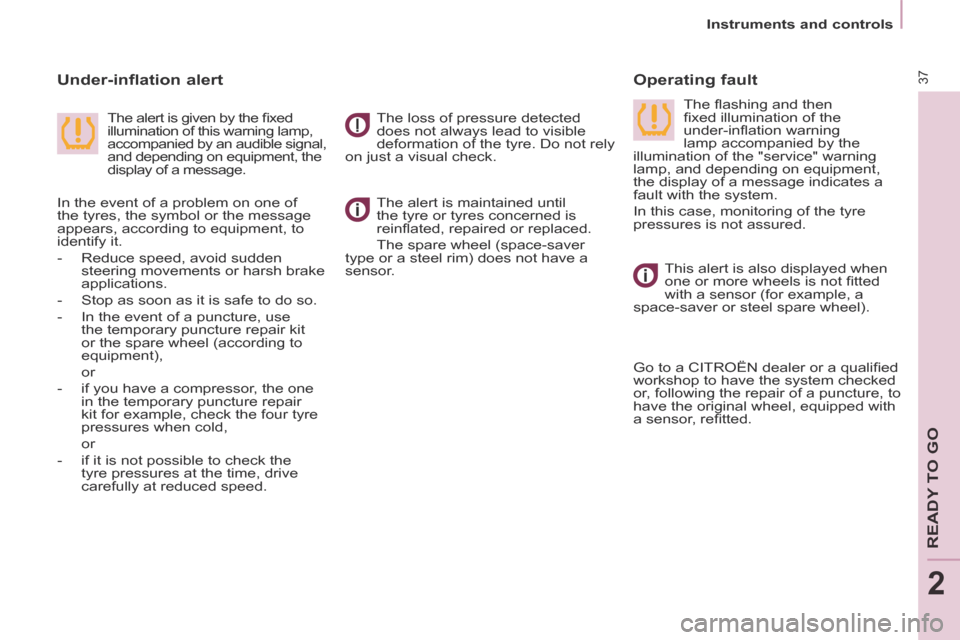
2
Instruments and controls
37
READY TO GO
The alert is maintained until
the tyre or tyres concerned is
reinfl ated, repaired or replaced.
The spare wheel (space-saver
type or a steel rim) does not have a
sensor.
Operating fault
Under-inflation alert
The loss of pressure detected
does not always lead to visible
deformation of the tyre. Do not rely
on just a visual check.
The alert is given by the fi xed
illumination of this warning lamp,
accompanied by an audible signal,
and depending on equipment, the
display of a message. The fl ashing and then
fi xed illumination of the
under-infl ation warning
lamp accompanied by the
illumination of the "service" warning
lamp, and depending on equipment,
the display of a message indicates a
fault with the system.
In this case, monitoring of the tyre
pressures is not assured.
In the event of a problem on one of
the tyres, the symbol or the message
appears, according to equipment, to
identify it.
- Reduce speed, avoid sudden
steering movements or harsh brake
applications.
- Stop as soon as it is safe to do so.
- In the event of a puncture, use the temporary puncture repair kit
or the spare wheel (according to
equipment),
or
- if you have a compressor, the one in the temporary puncture repair
kit for example, check the four tyre
pressures when cold,
or
- if it is not possible to check the tyre pressures at the time, drive
carefully at reduced speed. This alert is also displayed when
one or more wheels is not fi tted
with a sensor (for example, a
space-saver or steel spare wheel).
Go to a CITROËN dealer or a qualifi ed
workshop to have the system checked
or, following the repair of a puncture, to
have the original wheel, equipped with
a sensor, refi tted.
Page 40 of 268
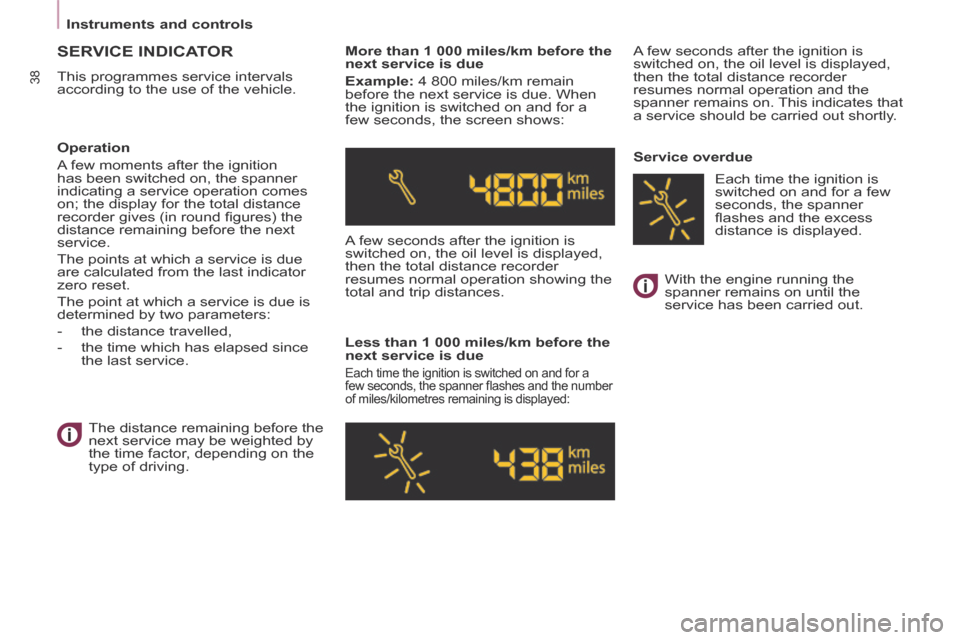
Instruments and controls
38
SERVICE INDICATOR
This programmes service intervals
according to the use of the vehicle. More than 1 000 miles/km before the
next service is due
Example: 4 800 miles/km remain
before the next service is due. When
the ignition is switched on and for a
few seconds, the screen shows:
A few seconds after the ignition is
switched on, the oil level is displayed,
then the total distance recorder
resumes normal operation showing the
total and trip distances.
Less than 1 000 miles/km before the
next service is due
Each time the ignition is switched on and for a
few seconds, the spanner fl ashes and the number
of miles/kilometres remaining is displayed:
A few seconds after the ignition is
switched on, the oil level is displayed,
then the total distance recorder
resumes normal operation and the
spanner remains on. This indicates that
a service should be carried out shortly.
Service overdue
Operation
A few moments after the ignition
has been switched on, the spanner
indicating a service operation comes
on; the display for the total distance
recorder gives (in round fi gures) the
distance remaining before the next
service.
The points at which a service is due
are calculated from the last indicator
zero reset.
The point at which a service is due is
determined by two parameters:
- the distance travelled,
- the time which has elapsed since
the last service.
The distance remaining before the
next service may be weighted by
the time factor, depending on the
type of driving. With the engine running the
spanner remains on until the
service has been carried out.
Each time the ignition is
switched on and for a few
seconds, the spanner
fl ashes and the excess
distance is displayed.
Page 41 of 268
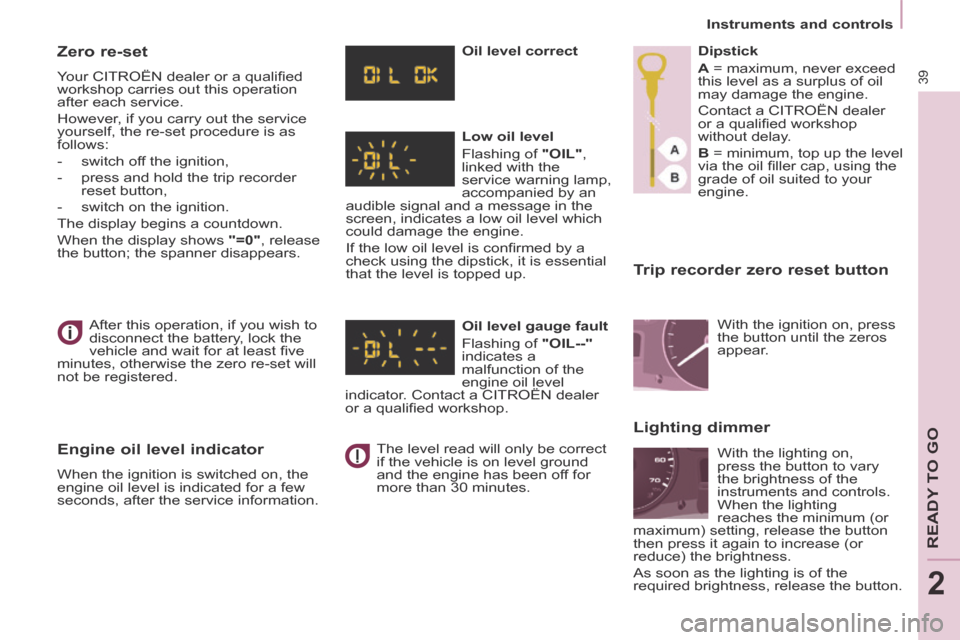
2
Instruments and controls
39
READY TO GO
Trip recorder zero reset button
After this operation, if you wish to
disconnect the battery, lock the
vehicle and wait for at least fi ve
minutes, otherwise the zero re-set will
not be registered.
Zero re-set
Your CITROËN dealer or a qualifi ed
workshop carries out this operation
after each service.
However, if you carry out the service
yourself, the re-set procedure is as
follows:
- switch off the ignition,
- press and hold the trip recorder reset button,
- switch on the ignition.
The display begins a countdown.
When the display shows "=0" , release
the button; the spanner disappears.
Engine oil level indicator
When the ignition is switched on, the
engine oil level is indicated for a few
seconds, after the service information. Oil level correct
Low oil level
Flashing of
"OIL" ,
linked with the
service warning lamp,
accompanied by an
audible signal and a message in the
screen, indicates a low oil level which
could damage the engine.
If the low oil level is confi rmed by a
check using the dipstick, it is essential
that the level is topped up.
Oil level gauge fault
Flashing of "OIL--"
indicates a
malfunction of the
engine oil level
indicator. Contact a CITROËN dealer
or a qualifi ed workshop.
The level read will only be correct
if the vehicle is on level ground
and the engine has been off for
more than 30 minutes. Dipstick
A = maximum, never exceed
this level as a surplus of oil
may damage the engine.
Contact a CITROËN dealer
or a qualifi ed workshop
without delay.
B = minimum, top up the level
via the oil fi ller cap, using the
grade of oil suited to your
engine.
Lighting dimmer
With the ignition on, press
the button until the zeros
appear.
With the lighting on,
press the button to vary
the brightness of the
instruments and controls.
When the lighting
reaches the minimum (or
maximum) setting, release the button
then press it again to increase (or
reduce) the brightness.
As soon as the lighting is of the
required brightness, release the button.
Page 47 of 268
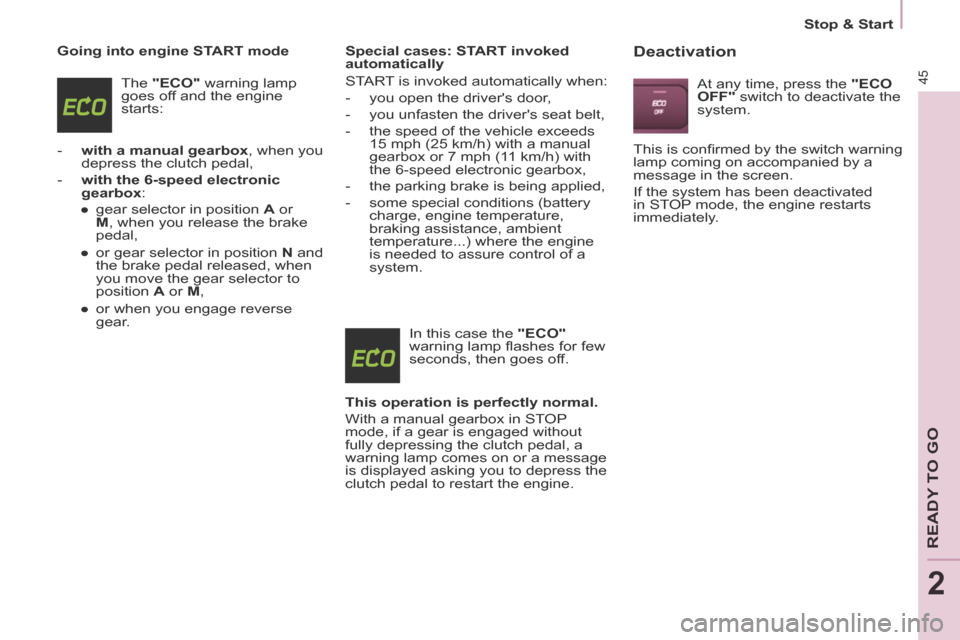
2
Stop & Start
45
READY TO GO
Going into engine START mode The "ECO" warning lamp
goes off and the engine
starts:
- with a manual gearbox , when you depress the clutch pedal,
- with the 6-speed electronic gearbox :
● gear selector in position A or
M , when you release the brake
pedal,
● or gear selector in position N and
the brake pedal released, when
you move the gear selector to
position A or M ,
● or when you engage reverse gear. Special cases: START invoked
automatically
START is invoked automatically when:
- you open the driver's door,
- you unfasten the driver's seat belt,
- the speed of the vehicle exceeds
15 mph (25 km/h) with a manual
gearbox or 7 mph (11 km/h) with
the 6-speed electronic gearbox,
- the parking brake is being applied,
- some special conditions (battery charge, engine temperature,
braking assistance, ambient
temperature...) where the engine
is needed to assure control of a
system.
In this case the "ECO"
warning lamp fl ashes for few
seconds, then goes off.
This operation is perfectly normal.
With a manual gearbox in STOP
mode, if a gear is engaged without
fully depressing the clutch pedal, a
warning lamp comes on or a message
is displayed asking you to depress the
clutch pedal to restart the engine. Deactivation
At any time, press the "ECO
OFF" switch to deactivate the
system.
This is confi rmed by the switch warning
lamp coming on accompanied by a
message in the screen.
If the system has been deactivated
in STOP mode, the engine restarts
immediately.
Page 56 of 268
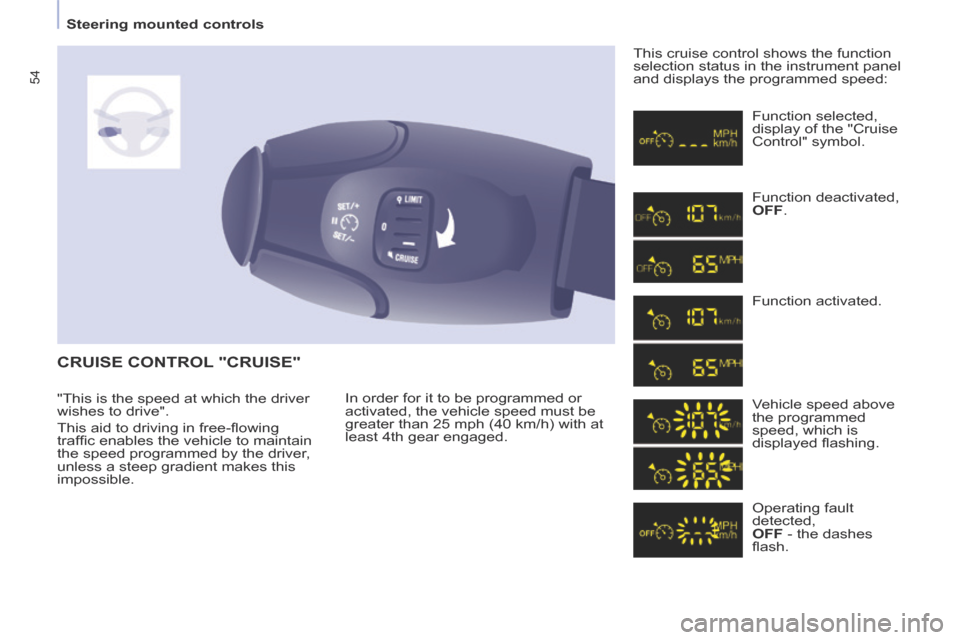
54
Steering mounted controls
CRUISE CONTROL "CRUISE"
In order for it to be programmed or
activated, the vehicle speed must be
greater than 25 mph (40 km/h) with at
least 4th gear engaged. This cruise control shows the function
selection status in the instrument panel
and displays the programmed speed:
Function selected,
display of the "Cruise
Control" symbol.
Function deactivated,
OFF .
Function activated.
Vehicle speed above
the programmed
speed, which is
displayed fl ashing.
Operating fault
detected,
OFF - the dashes
fl ash.
"This is the speed at which the driver
wishes to drive".
This aid to driving in free-fl owing
traffi c enables the vehicle to maintain
the speed programmed by the driver,
unless a steep gradient makes this
impossible.